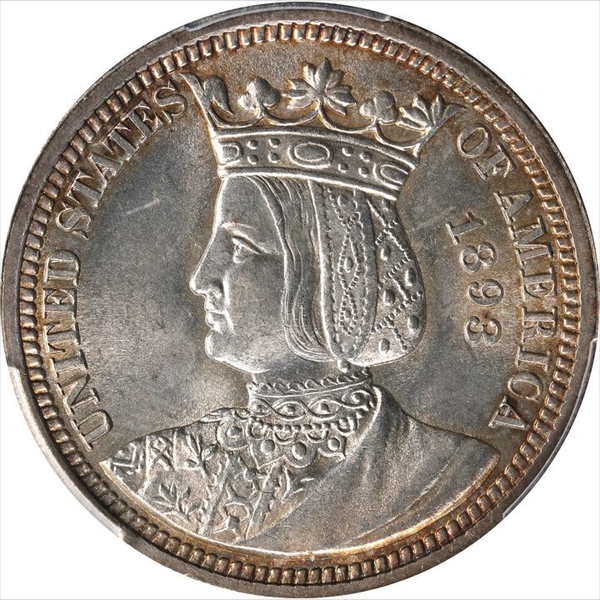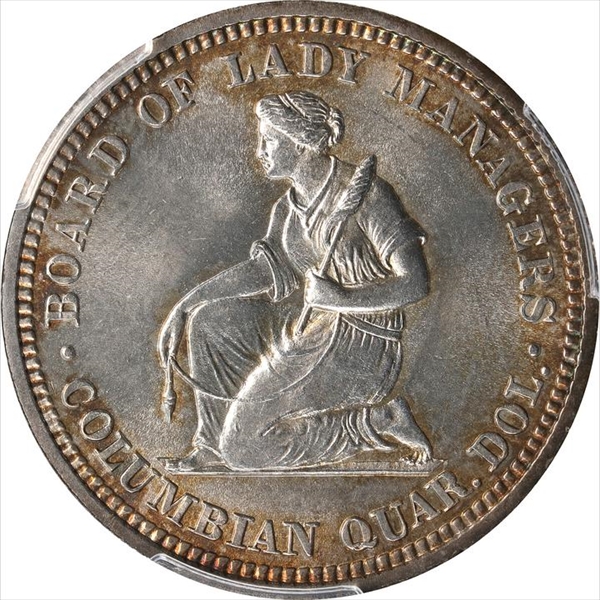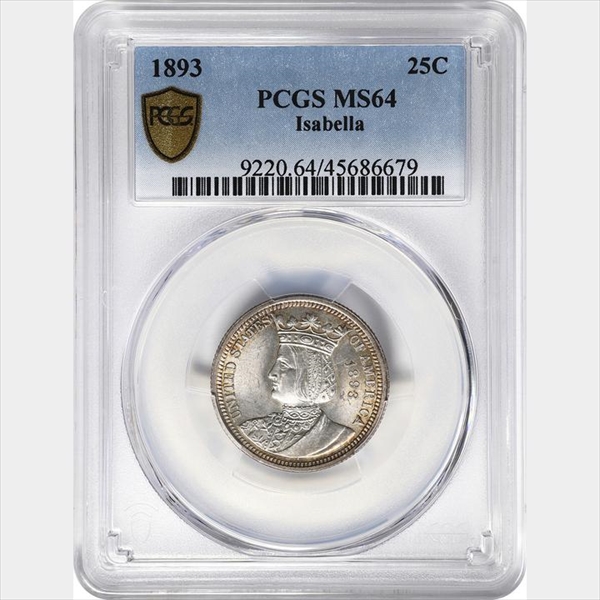1893 25C Isabella MS64 认证号45686679, PCGS号9220
专家评论
Ron Guth
THE ISABELLA QUARTER DOLLAR
Reprinted with permission from “Commemorative Coins of the
In January 1893, well after the Columbian half dollar was a reality, Mrs. Potter Palmer, well-known Chicago socialite, patron of the arts, and grande dame of the Exposition,[1] suggested to the Appropriations Committee of the House of Representatives that $10,000 of the money earmarked for the Board of Lady Managers of the World's Columbian Exposition be given in the form of a special issue of souvenir (as they were called) quarter dollars. This was translated into a law approved March 3, 1893, which stated that the production of these quarters would not exceed 40,000 and that the pieces would be of standard weight and fineness. Like the Columbian half dollars, the quarters would be made from metal taken from uncurrent silver coins held by the Treasury Department.
The Board of Lady Managers had been formed at the insistence of Susan B. Anthony, who has determined that women should be adequately represented in the administration of the Exposition. Interestingly, there was also a Board of Gentlemen Managers, but this did not get much publicity, as it was taken for granted. The Board of Lady Managers took complete charge of the quarter-dollar project and stated that the coins were to have female motifs. Kenyon Cox, a well-known illustrator, was commissioned to prepare sketches, apparently furnishing motifs that were eventually modified by Charles E. Barber at the Mint. However, another artist, Caroline C. Peddle, one of Cox's former art students, was also heavily involved and furnished sketches, all of which were eventually rejected.[2] For the obverse, a depiction of Queen Isabella of Spain was suggested, for King Ferdinand and Queen Isabella furnished the financing for Columbus' voyage of discovery, Isabella vowing to pledge her crown and jewels if necessary (according to popular legend).
In April 1893 the Treasury Department responded by submitting its own two obverse designs to the Board of Lady Managers, one sketch showing Isabella as a young queen (this was eventually chosen) and the other with a facing head of Isabella as an adult. Thus the Isabella quarter, as it was soon to be designated, became the first legal tender
The sketch for the reverse design depicted a woman kneeling, holding a distaff, showing woman's industry, although an alternative suggestion was that an illustration of the Woman's Building at the fair would be appropriate. The models and dies for the Isabella quarter were prepared by Charles E. Barber, chief engraver of the Mint, who also designed the obverse of the Columbian half dollar.
The American Journal of Numismatics in October 1893 reviewed the design: "Of its artistic merit, as of the harmony of which is reported to have prevailed at the meetings of the [Board of Lady Managers of the Woman's Department at the Exposition], perhaps the less said the better; we do not know who designed it, but in this instance, as in the half dollar, the contrast between examples of the numismatic art of the nation, as displayed on the Columbian coins, on the one hand, and the spirited and admirable work of the architects of the buildings, for instance, on the other, is painful.
"If these coins really represent the highest achievements of our medalist and our mints, under the inspiration of an opportunity without restrictions, the like of which has never been presented hitherto in the history of our national coinage, we might as well despair of its future, and we should be forced to believe that the merely mechanical side of the art of coining was all that was thought worthy of attention. We are not ready to admit this to be true."
Further from the same quotation: "Washington Irving once said, 'In America literature and the elegant arts must grow up side by side with the coarser plants of daily necessity.' The latter, surely, have not languished; the cultivation of the former, we firmly believe, is destined to reach as high a standard; but we must admit that we shall search in vain in our national coinage for evidence to sustain our confidence."
The account went on to note that the figure on the reverse of the Isabella quarter was "mournfully suggestive of the old antislavery token, AM I NOT A WOMAN AND A SISTER."[4]
Cornelius Vermeule in his superb study, Numismatic Art in America, commented that the motif of the kneeling woman on the reverse with distaff and spindle “could in 1892 [sic] owe pose and some details of drapery to a servant girl from the East Pediment of the Temple of Zeus at Olympia, work of about 460 B.C. with additions and revisions in the first or second centuries A.D. Nowadays the coin seems charming for its quaintness and its Victorian flavor, a mixture of cold Hellenism and Renaissance romance. Perhaps one of its greatest joys is that none of the contemporary inscriptions, mottoes and such, appear on it.”[5]
Contemporary Comments
By spring 1893 the newspapers had had their day with the Columbian half dollars, and little public or journalistic curiosity or interest remained for the 1893 Isabella quarter. Just a few scattered notices appeared in print, of which the following is typical:
“Mrs. Potter Palmer feels confident that the Isabella silver souvenir coins, granted by Congress to the Board of Lady Managers, will be ready for distribution by May 1st. There are but 40,000 of them, Congress having appropriated $10,000 to be minted in coins at 25¢ each, and already there are indications of efforts to buy them in quantities or ‘corner’ them.
“In some respects the Isabella souvenir coin may be an even greater novelty than the Columbus half dollar, since it is the first coin minted by the authority of the United States in special recognition of the place of women in the government, the state, or in great social and industrial movements. That the coins will command a premium, and proportionately a large premium, would seem to be certain, and already the Board of Lady Managers has received many communications accompanied by substantial checks offering to pay a handsome round sum for the first coin of the series.
“The coin itself will be of extremely artistic and beautiful design, and the issue will be one of perfect finish and involving the same care and painstaking attention as are given to the coining of the Columbian half dollars. The woman’s coin will be stamped with the portrait of Isabella of Spain, the first coin ever issued by this government bearing the portrait of a woman.[6] The general design is now being made by Kenyon Cox.
“The provision for this souvenir coin in the appropriation recently made by Congress for the Board of Lady Managers was intended by the national legislature to mark two important events: the aid given by Queen Isabella of Spain to Columbus in the furtherance of his voyage of discovery; and also emphasis of the fact that for the first time in the history of the world, special provision has been made by the United States Congress for the adequate participation of women in a great international enterprise.[7] The board has received several offers of $40,000 for the first 4,000 coins, in addition to special bids made for the first coin issued.”
The American Journal of Numismatics, April 1893, gave an optimistic view of impending sales of the Isabella quarter: “It was reported that at the Woman’s Building at the fair in
Production and Distribution
Production of the Isabella quarter dollars began at the Philadelphia Mint on June 13, 1893. The 1st, 400th, 1492nd, and 1892nd strikings were reserved with certificates, and the same were sent to the Board of Lady Managers in
A contemporary account related that on July 31, 1893 the Board of Lady Managers voted “to establish a building fund for the erection of a permanent structure commemorative of the work of woman at the World’s Fair.”[9] The same narrative envisioned a sellout of the coins: “It was agreed to reserve as a nucleus for the fund the premium realized from the sale of the Isabella souvenir coins, amounting to $30,000, and to this sum Mrs. Potter Palmer added her salary, amounting to $9,000.”
The 1893 Isabella commemorative quarter dollars received virtually no attention from the public and were lost in the shadow of the Columbian half dollar controversy. At the World’s Columbian Exposition itself, relatively few were purchased, probably because they represented less of a “good buy” at the dollar price demanded, for someone could buy a Columbian half dollar – a coin of twice the face value – for the same amount. While Columbian half dollars were sold through exhibits at several places at the fair, the only notable exhibit of Isabella quarters was in the Woman’s Building.
Writing in The Numismatist in May 1923 dealer Thomas L. Elder commented: “I bought 1,000 Isabella quarter dollars from the Exposition Committee once for 40 cents each, and many others at 45 cents.” B. Max Mehl, the Texas dealer who became a prominent factor in the commemorative coin resale market after about 1915, wrote the following about Isabella quarters in his 1937 monograph, The Commemorative Coins of the United States: “A great percentage of this number was purchased by a prominent member of the Board of Lady Managers and were afterwards released as the demand required. I well remember that these coins were obtained from the late Mr. Stevens[10] of
The “prominent member” was Mrs. Potter Palmer, and the quantity of Isabella quarters she sequestered was about 10,000, an incredible number.
Possibly as many as 15,000 Isabella quarters were sold at the Exposition and by mail to collectors and dealers in 1893, a miniscule quantity compared to the Columbian half dollar coins distributed. The biggest buyer is believed to have been the Scott Stamp & Coin Company, which purchased several thousand Isabella quarters late in the year 1893.
After the fair ended and a quantity had been disposed of to Scott, the Board of Lady Managers still had about 25,000 unsold pieces on hand, and, as noted, 10,000 of these were bought for face value by Mrs. Potter Palmer and several of her friends and were parceled out through coin dealers and others through the mid-1920s. Returned to the Mint for remelting were 15,809 unwanted coins.
Collecting Isabella Quarters
Unlike their half dollar counterparts, Isabella quarters were never released into circulation. For more than 10 years afterward the value on the collectors’ market did not fall significantly below the issue price of one dollar; thus numismatists continued to hold them in high esteem (until the 1910-1920 decade, at which time they were readily available in dealers’ stocks for as low as 65¢ each). Immediately after the Exposition closed a steady market for Isabella quarters ensued, quite unlike that for the Columbian half dollars issued in connection with the same event. Those who possessed unsold remainders were careful to sell them in modest quantities over a period of time without disturbing the price structure.
By 1896 an Isabella quarter had appreciated in value 50% and was fetching $1.50, prompting a contributor to The Numismatist to observe: “The Columbian quarter-dollar is already worth $1.50. A decade hence a specimen of this coin is likely to fetch $10.” Unfortunately for those reading this investment prediction, it turned out that over a half century would elapse before the Isabella quarter would cross the $10 mark! However, in the next following half century, the Isabella quarter would rise to over $1,000 in value.
Today nearly all known Isabella quarters are in
Isabella quarters are significant as the only commemorative coins of the 25-cent denomination (although it should be noted that the 1932 Washington quarter dollars were originally intended to be commemoratives, but it was decided to use the motif as a general issue to replace the Standing Liberty quarters which had been in circulation since 1916).
GRADING SUMMARY: Lower grade
SUMMARY OF CHARACTERISTICS
Commemorating: The Board of Lady Managers at the World’s Columbian Exposition; the 400th anniversary of the arrival of
Obverse motif: Portrait of Queen Isabella
Reverse motif: Kneeling woman
Authorization date: March 3, 1893
Date on coins: 1893
Date when coins were actually minted: 1893
Mint used:
Maximum quantity authorized: 40,000
Total quantity minted (including assay coins): 40,023
Assay coins (included in above): 23
Quantity melted: 15,809
Net number distributed (including assay coins): 24,214
Issued by: Board of Lady Managers, World’s Columbian Exposition,
Standard original packaging: Supposedly a small quantity was distributed in Board of Lady Managers envelopes; at least one private presentation box issued by a bank exists
Official sale price: $1
Designer of obverse and reverse: Charles E. Barber (following ideas of Kenyon Cox?)
Interesting facts: First
[1] Her husband owned the Palmer House, a leading hotel, and was also involved in merchandising.
[2] Caroline C. Peddle (1869-1938, a.k.a. Mrs. Caroline Peddle Ball) studied under Augustus Saint-Gaudens and Kenyon Cox. She exhibited at the Paris Exposition 1900, where her Victory sculpture was a feature of the
[3] The 1924 Huguenot-Walloon Tercentenary half dollar also depicted a monarch, William I, the “Silent” (1533-1584), of
[4] A relatively common token designated as Low-54 in the book, Hard Times Tokens, by Lyman H. Low, 1900.
[5] A reference to such statutory words and phrases as E PLURIBUS UNUM,
[6] The unknown writer of this unattributed newspaper account overlooked other women depicted on U.S. coins to that point, in the form of many personifications of Miss Liberty, various of which were modeled by real women, including (to cite just one example) Miss Anna Williams’ portrait on the 1878 and later Morgan silver dollars. However, Queen Isabella was the first woman to be specifically identified on a
[7] This is a commentary on Susan B. Anthony’s complaint to Congress that the 1876 Centennial Exhibition held in
[8] The Woman’s Building was dedicated on May 1, 1893. Members of the Board of Lady Managers included Mrs. Potter Palmer, Miss Catharine L. Miner, Mrs. John N. Logan, Mrs. Martha B. Stevens, Mrs. William Reed, Mrs. Margaret Blaine Saulsbury, and Mrs. Richard J. Ogelsby. Mrs. Susan G. Cooke was secretary.
[9] The Book of Fair, Bancroft, 1893, p. 303. Mrs. Palmer’s husband added a pledge of $200,000 to the building project, provided that a suitable site could be found.
[10] During the 1890s Stevens & Co., located at
David Hall
The 1893 Isabella quarter is one of the most important issues of the silver commemorative series. And it is also one of the most desirable. The Isabella has many things that distinguish it from it's silver commemorative half dollar brothers;
1. The Isabella is the only U.S. silver commemorative quarter, though it might be noted that the 1932 Washington quarter was originally intended as a commemorative issue, but morphed into the regular issue quarter series that is still minted today.
2. The Isabella quarter is one of the earliest U.S. commemoratives. Actually, it is the second issue of the commemorative series after the 1892 (and 1893) Columbian half dollar. This is an important factor in explaining the rarity of the early silver commemorative issues in Choice and Gem condition. There were a ton of different silver commemorative issues in the 1930s. But prior to 1934, there were a few issues minted every few years. The issues of the 1930s were generally saved at the time of issue and seldom saw circulation (ever seen a circulated Norfolk???) These 1930s era silver commemoratives are readily available in Gem condition. The earlier issues were also saved at the time of issue, but not in the enormous percentage of the mintage as the 1930s issues. Many of the earlier issues are often found in circulated condition. And many of them are quite rare in Gem and Superb Gem condition. The 1893 Isabella quarter did see some circulation, though since the issue price was $1.00, many were saved. Nonetheless, the Isabella quarter is rare in Gem condition.
3. The Isabella quarter is one of the highest demand issues in the silver commemorative series. Because it is the only quarter, because it is one of the earliest issue, because it is rare in top condition...all of these factors make the Isabella quarter one of the most sought after of all United States commemorative coins.
I've always been a big fan of this issue. In 1973, I spent about six months trying to buy every Gem Isabella I saw. I was paying $150 a coin at the time and managed to acquire about 80 pieces...and that was back in the days when good rare coins were a lot easier to buy. I've been dealing in Gem quality silver commems since 1973 and I always try to keep at least one Isabella quarter in stock at all times. To me it just doesn't seem like you're a commemorative dealer if you don't have an Isabella quarter.
The typical Isabella quarter grades MS62 to MS64. There are also quite a few lightly circulated "AU" examples. A small number of Isabellas found their way into circulation and worn pieces are occasionally encountered. Gem MS65 examples are rare, Superb Gem MS66 examples are very rare, and only a handful of MS67s exist. Isabellas usually have frosty luster and some can be highly lustrous. Isabellas also come with varying degrees of toning, including some beautiful rainbow Gems. Most Isabellas are well struck and most don't seem to have many marks or abraisions.
稀有性和存量估计 了解更多
| 所有评级 | 20000 |
| 60或以上 | 16500 |
| 65或以上 | 1750 |
| 所有评级 | R-2.8 |
| 60或以上 | R-2.8 |
| 65或以上 | R-4.7 |
| 所有评级 | 96 / 144 TIE |
| 60或以上 | 103 / 144 TIE |
| 65或以上 | 23 / 144 TIE |
| 所有评级 | 96 / 144 TIE |
| 60或以上 | 103 / 144 TIE |
| 65或以上 | 23 / 144 TIE |



























